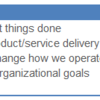CircleID takes a look at America's Broadband Score
"Leonard Waverman, the dean of the Haskayne School of Business at the University of Calgary, describe a measure he developed called the 'Connectivity Scorecard.' It's meant to compare countries on the extent that consumers, businesses and government put communication technology to economically productive use. Even after deducting the untold unproductive hours spent on Facebook and YouTube, the United States comes out on top..."
What's interesting to me is the comments. How no one can find the US Broadband score is funny. (Heard of Google much?) It isn't so much the score as what the score represents.
We have a few problems to fix:
(1) ISP Competition for one. Many places only have one choice for broadband. Many have two - cable or telco. Few have three. It makes download caps and Net Neutrality a hot button that true competition would eliminate. (And please don't give me that 3G is the third rail because guess who owns that - Ma and Pa Bell in the majority just like they own the Internet backbone and the PSTN structure in more than 70% of the country).
(2) A definition of broadband. Is it 256k one way as the FCC has defined it for years? Is it now the new FCC definition of 768k? Or is it 1M x 1M minimum? Or is it 100Mbps? This would certainly help.
(3) Deployment versus Penetration. "When you look at the 2008 ITIF Broadband Rankings report ...the U.S. ranked 15th among industrial nations at a composite score of 10.25. The U.S. is reported to have an average download speed of 4.9 Mbps, which is a far distant behind Japan's 63.6 Mbps. In addition, the report states that the US broadband penetration comes in at 0.57%." [source] Here's the detail: "Composite Score: Each nation's overall score is the sum of its standard deviation score for each of the three indicators: Household penetration or subscribers per household, average download speed in Mbps and price at the lowest monthly cost per Mbps."
We may have "broadband" deployed in a large swath of America, but the speed is low compared to other countries. Because we are a suburban and rural country, it takes more infrastructure to hit everywhere with broadband, especially very high-speed Internet Access (greater than 3Mbps). And because most places hit are single family homes - we do live in suburban sprawl consisting of McMansions filled with Yuppies and 2.2 kids - it also affects our score at the ITIF. According to a CWA study, the speed in the US is just over 2Mbps.
(4) Cost! We probably pay more per MB than any other G8 country. We get less speed and pay more for it. That hurts us. Surprisedly, in Wilson NC, the Muni fiber sells 100MB symmetric while TWCable and Embarq just gape at the speed and price. Well, not gape, so much as sue that it's unfair that a city would provide services it refuses to.
So we have cost, penetration, subscriber per household (density), and speed. Can't do much about density, but you can improve speed and cost. Also, there is a Digital Divide in America. Poorer families do not have computers, so do not have a need (or a budget) to buy broadband. It poses a problem that funding broadband for libraries and schools is supposed to throw a rope at. The Pew Report reflects this chasm.
BTW, the Connectivity Scorecard study has been analyzed here and by my favorite snarky blog, TechDirt.
agents apps att broadband broadsoft cable cableco cellular channel partners clec cloud communications cloud computing commissions data center FCC fcc fiber financials hosted pbx internet itexpo marketing master agency mergers politics sales security sellecom selling strategy TCA telecom is broken UC unified messaging VAR voip vz vzw wireless wireline
- AI (4)
- Add category (2)
- BPI (10)
- BPaaS (10)
- CALEA (2)
- CLEC (250)
- FCC (200)
- FTC (10)
- IOT (17)
- IPTV (14)
- ISP (60)
- Internet (248)
- Marketing (283)
- PBX (180)
- PR (27)
- SDN (46)
- TCA (72)
- TEM (16)
- TMC (26)
- VAD (9)
- VAR (149)
- VDI (10)
- Web 2.0 (48)
- Yahoo (9)
- agents (446)
- amazon (23)
- apps (122)
- backup (41)
- bandwidth (70)
- bellsouth agent (22)
- books (15)
- broadband (235)
- broadsoft (124)
- cableco (200)
- cellular (243)
- certification (17)
- channel (432)
- cloud computing (286)
- colocation (43)
- commissions (103)
- communications (66)
- compliance (22)
- comptia (5)
- conferences (66)
- conferencing (68)
- crm (8)
- cybersecurity (2)
- data center (128)
- disaster recovery (35)
- duopoly (71)
- e-book (4)
- economy (129)
- email (27)
- ethernet (23)
- expo (117)
- fiber (124)
- glossary (2)
- hosted uc (266)
- im/chat (28)
- jobs (32)
- linkedin (38)
- managed services (54)
- master agency (68)
- mergers (395)
- metaswitch (12)
- mobile (57)
- mpls (55)
- msp (50)
- off topic (48)
- organizations (82)
- outage (19)
- politics (136)
- privacy (41)
- saas (92)
- sales and selling (271)
- satellite (17)
- sdn (28)
- security (94)
- sip trunking (83)
- smb (65)
- social network (76)
- spectrum (68)
- startup (27)
- technology (134)
- telco (253)
- tele-presence (22)
- telecommunications (229)
- training (42)
- twitter (44)
- unified communications (258)
- vc (9)
- video (86)
- voip (436)
- webRTC (16)
- wi-fi (29)
- wimax (33)
- wireless (167)
- wireline (179)
- xmpp (5)
- xo (54)
- September 2017
- August 2017
- July 2017
- June 2017
- May 2017
- April 2017
- March 2017
- February 2017
- January 2017
- December 2016
- November 2016
- October 2016
- September 2016
- August 2016
- July 2016
- June 2016
- May 2016
- April 2016
- March 2016
- February 2016
- January 2016
- December 2015
- November 2015
- October 2015
- September 2015
- August 2015
- July 2015
- June 2015
- May 2015
- April 2015
- March 2015
- February 2015
- January 2015
- December 2014
- November 2014
- October 2014
- September 2014
- August 2014
- July 2014
- June 2014
- May 2014
- April 2014
- March 2014
- February 2014
- January 2014
- December 2013
- November 2013
- October 2013
- September 2013
- August 2013
- July 2013
- June 2013
- May 2013
- April 2013
- March 2013
- February 2013
- January 2013
- December 2012
- November 2012
- October 2012
- September 2012
- August 2012
- July 2012
- June 2012
- May 2012
- April 2012
- March 2012
- February 2012
- January 2012
- December 2011
- November 2011
- October 2011
- September 2011
- August 2011
- July 2011
- June 2011
- May 2011
- April 2011
- March 2011
- February 2011
- January 2011
- December 2010
- November 2010
- October 2010
- September 2010
- August 2010
- July 2010
- June 2010
- May 2010
- April 2010
- March 2010
- February 2010
- January 2010
- December 2009
- November 2009
- October 2009
- September 2009
- August 2009
- July 2009
- June 2009
- May 2009
- April 2009
- March 2009
- February 2009
- January 2009
- December 2008
- November 2008
- October 2008
- September 2008
- August 2008
- July 2008
- June 2008
- May 2008
- April 2008
- March 2008
- February 2008
Featured Videos













